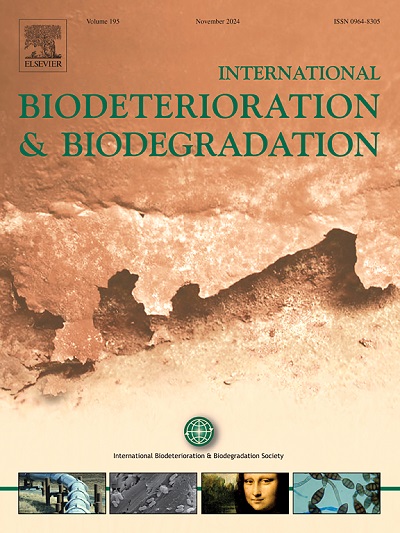铜绿假单胞菌外排泵及其多药耐药调控机制
IF 4.1
2区 环境科学与生态学
Q2 BIOTECHNOLOGY & APPLIED MICROBIOLOGY
International Biodeterioration & Biodegradation
Pub Date : 2025-04-14
DOI:10.1016/j.ibiod.2025.106096
引用次数: 0
摘要
铜绿假单胞菌是一种机会性革兰氏阴性细菌病原体,由于其能够引起各种人类感染,是医院重症监护病房的重大威胁。其庞大的基因组使其对环境变化具有显著的适应性,从而导致抗生素和多药耐药性(MDR)的发展。铜绿假单胞菌(P. aeruginosa)菌株的染色体中含有许多抗性基因,其中大多数与外排泵(EPs)有关。这些基因主要负责抗生素和耐多药。外排系统是铜绿假单胞菌耐多药耐药的关键,包括六个主要的EP蛋白家族:atp结合盒、主要促进剂、多药和毒素挤出、小的耐多药耐药、变形菌抗菌化合物外排和耐药结瘤细胞分裂(RND)超家族。其中,RND EPs是最关键的,显示出最广泛的底物光谱,与MDR的相关性最强。铜绿假单胞菌基因组编码12个RND EPs,它们表现出重叠但不同的底物范围。值得注意的是,MexAB、MexXY、MexCD和MexEF EPs对MDR有显著贡献。铜绿假单胞菌的EP系统是独特的,其基因序列与其他革兰氏阴性和革兰氏阳性细菌的EP系统不同,这使得EP抗性基因的种间基因转移不常见。EP抑制剂(EPIs)具有提高抗生素抗铜绿假单胞菌感染临床疗效的潜力。然而,迄今为止还没有EPIs应用于临床抗感染治疗。因此,迫切需要深入探索铜绿假单胞菌EP系统的分子结构、功能和机制。开发低毒、高效、广谱的EPIs是推动和加快其临床应用的关键。本文章由计算机程序翻译,如有差异,请以英文原文为准。
Efflux pumps of Pseudomonas aeruginosa and their regulatory mechanisms underlying multidrug resistance
Pseudomonas aeruginosa, an opportunistic gram-negative bacterial pathogen, is a significant threat in hospital intensive care units due to its ability to cause various human infections. Its large genome enables remarkable adaptability to environmental changes, resulting in the development of antibiotic and multidrug resistance (MDR). The chromosomes of P. aeruginosa strains harbor numerous resistance genes, the majority of which are related to efflux pumps (EPs). These genes are primarily responsible for antibiotic and MDR. Efflux systems are pivotal in P. aeruginosa MDR, comprising six major EP protein families: ATP-binding cassette, major facilitator, multidrug and toxin extrusion, small MDR, proteobacterial antimicrobial compound efflux, and resistance nodulation cell division (RND) superfamilies. Among these, RND EPs are the most critical, displaying the broadest substrate spectrum and the strongest correlation with MDR. The P. aeruginosa genome encodes twelve RND EPs, which exhibit overlapping but distinct substrate ranges. Notably, MexAB, MexXY, MexCD, and MexEF EPs contribute significantly to MDR. EP systems in P. aeruginosa are unique, with gene sequences distinct from those of EP systems in other gram-negative and gram-positive bacteria, making interspecific gene transfer of EP resistance genes uncommon. EP inhibitors (EPIs) possess the potential to promote the clinical efficacy of antibiotics against P. aeruginosa infections. However, no EPIs have been applied in clinical anti-infective treatment to date. Consequently, there is an urgent need for in-depth exploration of the molecular structures, functions, and mechanisms of P. aeruginosa EP systems. Developing low-toxicity, high-efficacy, and broad-spectrum EPIs is crucial to drive and accelerate their clinical application.
求助全文
通过发布文献求助,成功后即可免费获取论文全文。
去求助
来源期刊
CiteScore
9.60
自引率
10.40%
发文量
107
审稿时长
21 days
期刊介绍:
International Biodeterioration and Biodegradation publishes original research papers and reviews on the biological causes of deterioration or degradation.

 求助内容:
求助内容: 应助结果提醒方式:
应助结果提醒方式:


